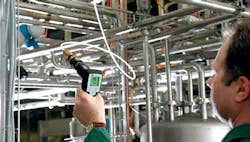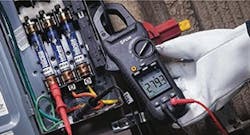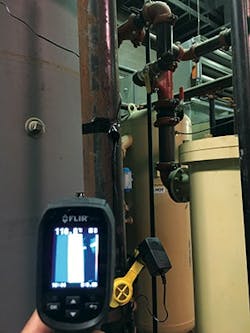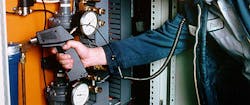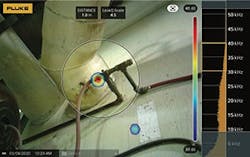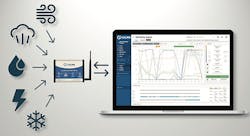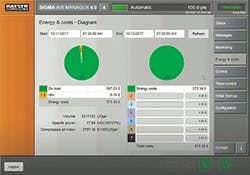Digital tools for compressed air system measuring and monitoring
Most are familiar with the common tools and measuring devices that have been used on compressed air systems over the years, but you may not be aware that recent technological advances have brought some new innovations to the forefront. Gone are the days of analog gauges and flashing warning lights. Some new digital tools have been developed to help you understand and monitor your compressed air system, and most of these devices are affordable even for smaller operators. This article discusses some “modern day compressed air tools” that can help air system owners diagnose, measure, and monitor the condition, status, and efficiency of their valuable equipment. It should be noted that this is just a small sample of what is available to the plant operator.
Measuring tools
Figure 1. Newer compressor controllers have sophisticated monitoring capabilities. This one has web connection capabilities and shows a histogram of its output history to help the operator ensure the unit is operating correctly. Source: Atlas Copco
Every air compressor and dryer has always had basic onboard gauges to help service technicians diagnose if repairs are needed. In the old days, it was common to have only analog temperature and pressure gauges, and to have a set of hour meters to determine when maintenance is needed, important variables to track for compressed air systems. And a technician might also use a simple clamp-on ammeter with a voltmeter to check the incoming voltage and current to ensure things are running properly. But the world of compressed air has changed; better tools for the “toolbox” are available to help monitor your system.
Electronic compressor controls
Figure 2. A good power meter with capability of measuring harmonics and power factor is an essential part of a modern toolbox. This model has wireless communications capabilities. Source: FLIR
More modern compressors now have sophisticated IoT (Industry 4.0) enabled electronic controls, many with digital touch screen displays, and some even tracking internal conditions over a set time span for use in local troubleshooting problems (see Figure 1). Where an older controller might have an “idiot light” alarm or two, the newest and most modern controllers track a wide array of internal conditions and have adjustable alerts that can be hooked to the local internet, or programmed to send text messages when conditions turn bad. Some premium compressors are now coming with pre-programmed web pages, and even cell modems that send data back to the OEM for analysis; this information is often available to the user on a subscription basis. Usually, these controls can be queried remotely by maintenance personnel on a smartphone without having to walk to the compressor room.
Power quality
Figure 3. This FLIR camera is detecting abnormally high temperatures on a heated air dryer. Source: Marshall CA
Many new compressors are now being purchased with variable frequency drives to save energy. Installing one of these premium efficiency machines is an excellent way to greatly improve the efficiency of a system, but they require good quality electrical power and a clean and cool environment. An important addition to a maintenance toolbox is a good power quality meter (see Figure 2) to detect things like phase imbalances, low voltages, harmonic distortion, and conditions that may consume abnormal power. When measuring input conditions and calculating compressor efficiency (to prove your new VSD is saving money), it is important to get actual kilowatt readings and to determine the power factor so that calculations can be done correctly.
Heat detection
Very often temperature problems cause reliability challenges with air compressors and dryers. These days Infrared (IR) detectors are very affordable and can be used in measuring and tracking critical temperatures. More sophisticated, but affordable, low-cost IR cameras (see Figure 3) are available that give users a complete thermal image of operating equipment. The use of a camera can show how electrical components, compressor coolers, motors, and bearings are performing, all found with a quick glance at a thermal signature.
Leak detectors
Another valuable addition to any toolbox is an ultrasonic leak detector. In the past these devices have not been affordable for the average maintenance worker, but now basic units can be purchased for less than $1,000, and at this price level there is really no excuse for not having at least one detector in a plant. Repair of only five cfm of leaks at present day power costs will pay the cost of a basic leak detector in less than a year (see Figure 4).
Ultrasonic leak detectors are very valuable tools to use in reducing waste, and have become more advanced in past years, allowing you to put away your clipboard. There are free smartphone apps that can help you identify and record leakage locations, even storing pictures. Being able to turn off a compressor after a leak repair is the best way to save maintenance costs and save power. Odds are if you don’t have a leak repair program in your plant, you are running too much compressor capacity, or even running out!
Most leak detector suppliers have developed high-end models that have onboard cameras that take pictures of each leak, record location information, and even provide some rough estimation of the leakage flow based on the decibel level. The collected data is uploaded to a cloud database for recording and tracking purposes.
Figure 5. The output of this Fluke ii900 leak detector shows exactly where each leak is located. Source: Fluke
There are now some exciting new cutting-edge leak detectors available that use complicated arrays of microphones to create an acoustical signature overlaid onto a video screen (see Figure 5). This approach gives a very clear picture of the location and size of leaks, something that can be difficult to determine if a leak is not readily accessible. While a bit pricey, this visual type of detection saves time and money and will be the way of the future.
Air quality
Few realize the dew point display on a refrigerated air dryer is not the “real” dew point; it is just a measure of the temperature of the compressed air inside the dryer. In theory, the dew point output should be near this temperature, but there are a few abnormal conditions, such dryer drain failure, that can fool the user into a false sense of security, all the while moisture is collecting in downstream piping. Similar things can happen with desiccant dryers where onboard dew point probes can become out of calibration, or fail altogether, causing the dryer to fail.
Figure 6. Spot testing of dew point can reveal problems with air drying equipment. Source: Ultrafilter
A good addition to any collection of maintenance instruments is a portable dew point tester (see Figure 6). Some of these systems can come at significant cost; however, some affordable sensors under $1,000 can be put together by purchasing a simple low-cost probes and connecting to any inexpensive 4 to 20 milliamp display.
If your plant produces food products or other products that might be affected by lubricants, particles, or microbes, there are more costly (but very sensitive) measuring devices now available that can track hydrocarbons and count particles by size using lasers to ensure that the produced compressed air is meeting cleanliness requirements.
Flow measurement
So, with the compressor humming along nicely due to your excellent maintenance, answer this question: how much compressed air is it producing? Most compressed air users don’t know the answer because compressors don’t come with flow meters. But now you can measure the flow in an affordable way, and if you also measure power you can calculate the compressed air system’s “gas mileage” or using the correct terminology, the specific power. Usually reported as kilowatts per 100 cfm, the specific power tells how efficiently the compressed air is being produced. An efficient system would be producing air at 16 kW per 100 cfm, some poor performers have been found at 40 kW per 100 cfm (or even much higher).
Figure 7. This thermal mass meter can be installed on a pressurized system to measure a dry flow of compressed air. Analog, digital, or wireless outputs can be tracked by data logging instruments. Source: CDI Meters
Recent technological advances have reduced the cost of flow meters substantially, making them much more accurate and easier to use. The most common type is a thermal mass style, suitable only for the measurement of dry air. But many companies have devices that can measure wet air directly at the output of the air compressor. Mounting a portable flow meter on a pipe can be a great instrument for measuring leaks and end uses.
Can’t shut down? Most flow meters can be installed while the system is pressurized using hot tap techniques (see Figure 7). Some flow meters come with directional characteristics that make them the most suitable for installation on ring piping systems where the compressed air can flow in either direction.
Measurement suites designed for compressed air
How useful would it be to view the outputs of all your measurement instruments in one place, while sitting at your desk? During compressed air audits multiple instruments are placed and data captured to produce a time-based profile of the system pressures, power, flow, and air quality. From this data an experienced auditor can quicky determine what problems your system is experiencing, and often discover interesting things about your system. In past years, the data logging equipment used has been generic, but some innovative companies have developed affordable measurement suites specifically designed for compressed air (see Figure 8).
These systems usually come in two arrangements: (1) using self-contained battery powered devices to measure the various parameters; or (2) central systems bringing measurement results to a central data collection box. The self-contained style is much more useful for remote readings outside the compressor room. The central systems typically have more memory and so can collect data longer and in finer detail.
Once the data is collected it can be displayed on a chart for visual analysis and sent to special algorithms that calculate system baseline values and key performance indicators. Some of these systems have the capability of simulating how systems would work after improvement measures are applied, calculating the electrical cost reductions. Most systems have some sort of automatic report generator to reduce the work for the assessor.
Most of the companies that offer auditing suites also have permanent versions available that can provide complete system dashboards allowing real-time monitoring of a system. This type of system can be used as an input to a full facility energy management system such as ISO 50001.
Hidden capabilities
Figure 9. Compressor controllers often have energy efficiency reports built into the operating systems; this shot is showing excellent efficiency of 17.99 kW per 100 cfm. Source: Kaeser
Very often compressed air systems with multiple compressors will have a central master controller that efficiently orchestrates the operation of all the compressors. If this controller has been installed in the last few years, it is likely that it has some sort of data collection capability built right in. Most of these controllers can generate regular reports that assess the efficiency and reliability of your compressed air system over a certain period of time (see Figure 9).
Agnostic systems
One common problem with OEM supplied controllers is that many require all the compressors in the system to be from the same manufacturer. While this problem is being improved, it is something that causes difficulty, especially when existing older compressors can’t “speak” the correct communication protocol.
Some innovative third-party companies have developed instrumentation packages with cell phone connectivity that can be installed on any compressor as a retrofit to provide standardized condition and efficiency monitoring (see Figure 10). Measurements are sent to a cloud database for continuous monitoring and stored for later analysis. Often these systems can be adapted for future efficient compressor control through upgrades to the hardware.
Compressed air toolbox
Now, more than ever, is the right time to assemble a “toolbox” full of some affordable and incredibly useful modern day compressed air tools. And as technology advances more and more innovative equipment will be developed to help keep your equipment running more efficiently and reliably.
About the Author
Ron Marshall
Ron Marshall first developed his skills as an industrial compressed air systems expert at Manitoba Hydro, where he worked for 38 years, supporting more than 600 energy efficiency projects. He now operates his own compressed air energy efficiency consulting firm where he provides technical advice, system auditing, and training. Ron is a level 2 instructor with Compressed Air Challenge and conducts training internationally. Contact him at [email protected].Want to learn more about compressed air? We would suggest sending key staff to one of our Compressed Air Challenge seminars to help them learn what is possible. To learn more about upcoming training opportunities visit the CAC calendar at https://www.compressedairchallenge.org/calendar.
